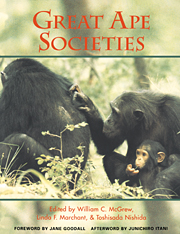Book contents
- Frontmatter
- Contents
- List of contributors
- Preface
- Foreword: conserving great apes
- Part I Apes overviewed
- 1 Toward an understanding of the orangutan's social system
- 2 Comparative socio–ecology of gorillas
- 3 Comparative socio–ecology of Pan paniscus
- Part II Social ecology
- Part III Social relations
- Part IV Minds
- Part V Apes compared
- Part VI Modeling ourselves
- Afterword: a new milestone in great ape research
- Appendix: great ape study sites
- Index
1 - Toward an understanding of the orangutan's social system
Published online by Cambridge University Press: 04 August 2010
- Frontmatter
- Contents
- List of contributors
- Preface
- Foreword: conserving great apes
- Part I Apes overviewed
- 1 Toward an understanding of the orangutan's social system
- 2 Comparative socio–ecology of gorillas
- 3 Comparative socio–ecology of Pan paniscus
- Part II Social ecology
- Part III Social relations
- Part IV Minds
- Part V Apes compared
- Part VI Modeling ourselves
- Afterword: a new milestone in great ape research
- Appendix: great ape study sites
- Index
Summary
INTRODUCTION
The aim of primate socioecology is to clarify how social structure and organization are influenced by the interaction between ecological factors and biological constraints. A coherent theoretical framework is gradually being developed to account for the interspecific and intraspecific variation found among primates (Wrangham, 1980, 1987; Dunbar, 1988; Watts, 1989; van Schaik, 1989; van Schaik & Dunbar, 1990), and specific models are increasingly being subjected to empirical tests. These tests will lead to further refinements in these models, which therefore promise to make important contributions to our understanding of the origins of human social behavior and social systems.
Orangutans (Pongo pygmaeus) stand out among diurnal primates in several ways. Adults are largely solitary, have low interaction and association rates, show extreme sexual dimorphism in body size and appearance, show pronounced bimaturism among sexually mature males, engage in forced copulations (especially non-resident males), display female mating preferences in favor of some males and in opposition to others, and range in seasonal or irregular movements, which seem to make it impossible to distinguish spatially discrete communities (social units). All of these unique or unusual features have yet to be reconciled with existing socioecological and sociobiological ideas. It is likely that they are interrelated in as yet unknown ways.
In order to develop good theoretical models and to perform valid tests, we must have good descriptive information on all relevant features of a population's social system.
- Type
- Chapter
- Information
- Great Ape Societies , pp. 3 - 15Publisher: Cambridge University PressPrint publication year: 1996
- 63
- Cited by

